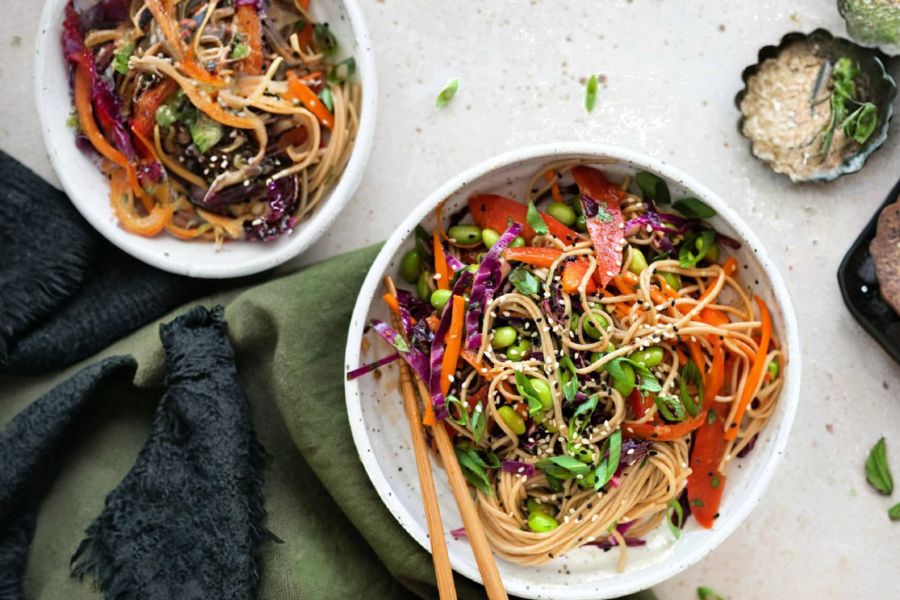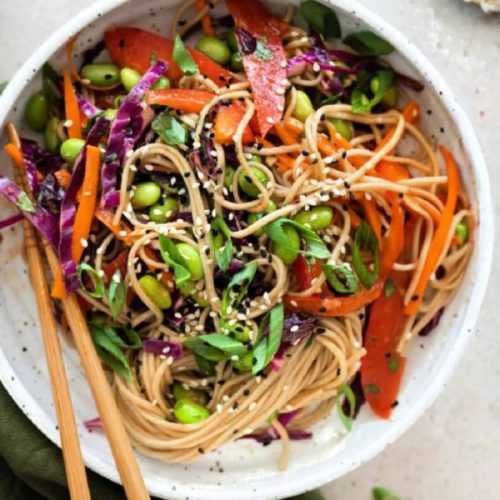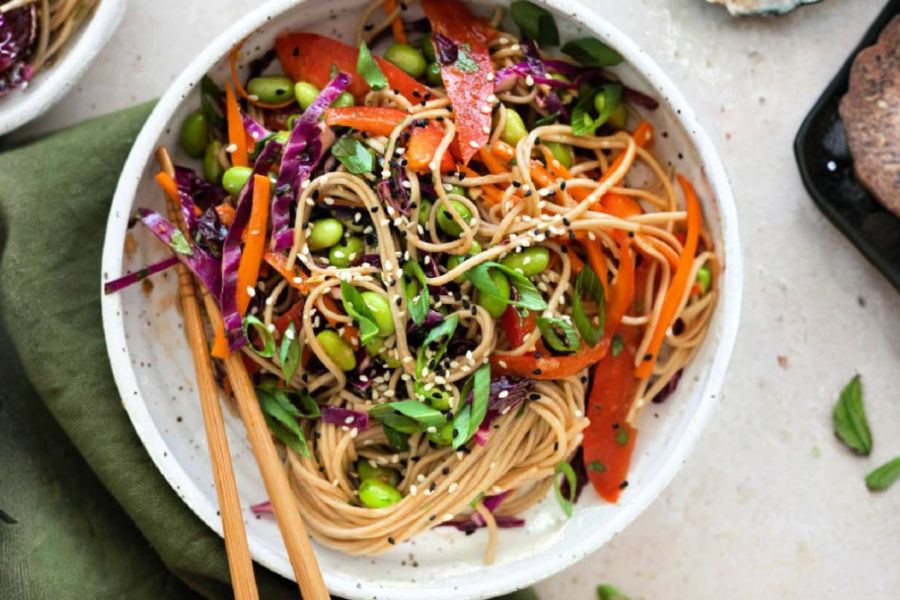This Soba Noodle Salad is a vibrant, satisfying dish that balances flavor, texture, and nutrition.
The chewy soba noodles combined with crisp vegetables and edamame create a fiber-rich, protein-packed base, while the tangy-sesame dressing delivers a punch of umami without excess fat.
High in plant-based protein and good fats from sesame oil, this salad is heart-healthy, low in saturated fat, and naturally nutrient-dense.
It’s also incredibly versatile: ready in just 20 minutes, it works as a quick lunch, a light dinner, or a make-ahead meal for busy weekdays.

The combination of fresh herbs, crunchy vegetables, and bold dressing makes each bite refreshing and crave-worthy, making it an easy way to enjoy a wholesome, balanced meal that satisfies both taste and nutrition.
Must-Have Tools for Perfect Results
Large Pot
Essential for cooking soba noodles evenly without sticking. Beyond this recipe, it’s a versatile staple for boiling pasta, blanching vegetables, or simmering soups.
Whisk
Perfect for emulsifying the tangy sesame dressing into a smooth, balanced flavor. A whisk is invaluable for sauces, batters, and salad dressings alike.
Large Bowl
Ideal for tossing noodles, vegetables, and dressing together without spilling. It doubles as a mixing or serving bowl for countless dishes.
Colander
Used to drain and rinse soba noodles, ensuring they stay separate and cool. Great for washing greens, draining pasta, and prepping grains.
Measuring Spoons & Cups
Precise measurements of soy sauce, oils, and seasonings help maintain consistent flavor. These tools are fundamental for reliable results in any home-cooked recipe.

20-Minute Soba Noodle Salad
Equipment
- 1 Large Pot
- 1 whisk
- 1 Large Bowl
- 1 Colander
- Measuring spoons & cups
Ingredients
Salad:
- 8 ounces dry soba noodles
- 1 cup frozen shelled edamame thawed
- 1 cup finely shredded purple or green cabbage
- 1 large red bell pepper thinly sliced
- 1 cup julienned carrots
- ½ cup chopped cilantro leaves
- ⅓ cup sliced green onion about 3 stalks
Dressing:
- 3 tablespoons low-sodium soy sauce
- 2 tablespoons fresh lime juice
- 2 tablespoons rice vinegar
- 2 tablespoons neutral oil olive, avocado, sunflower, or grapeseed
- 1 tablespoon toasted sesame oil plus 1 teaspoon for drizzling
- 1 tablespoon agave nectar or maple syrup
- 1 tablespoon minced fresh ginger
- 2 –3 teaspoons sriracha
- 1 clove garlic minced
- Toppings optional:
- Black or white sesame seeds
- Chopped cilantro
- Sliced green onions
Instructions
- Prepare the Dressing: In a medium bowl, combine soy sauce, rice vinegar, fresh lime juice, neutral oil, toasted sesame oil, agave nectar, minced ginger, sriracha, and garlic. Whisk thoroughly until the ingredients form a smooth, harmonious emulsion, ensuring every flavor is balanced and vibrant. Taste and adjust seasoning if necessary, then cover and refrigerate while you prepare the salad components to allow flavors to meld.
- Cook the Soba Noodles: Bring a large pot of water to a rolling boil and add the soba noodles, stirring occasionally to prevent sticking. Cook according to package instructions until tender but still slightly firm to the bite. Drain the noodles in a colander, then rinse thoroughly under cold running water to stop the cooking process and remove excess starch. Drizzle with a teaspoon of sesame or neutral oil and gently toss so the noodles remain separated and glossy.
- Assemble the Salad Base: In a large mixing bowl, combine the cooled soba noodles with edamame, shredded cabbage, julienned carrots, thinly sliced red bell pepper, chopped cilantro, and sliced green onions. Toss carefully with your hands or salad tongs to evenly distribute all ingredients without bruising the vegetables, creating a colorful, balanced, and textured foundation for the salad.
- Dress and Serve: Pour the prepared dressing over the noodle-vegetable mixture and toss gently to coat every strand and piece of vegetable evenly. Taste and adjust the seasoning, adding more lime juice, sriracha, or sesame oil if desired. Transfer to a serving bowl or individual plates and finish with a sprinkling of sesame seeds, extra cilantro, and green onions for a fresh, visually appealing presentation. Serve immediately, enjoying the vibrant flavors, chewy textures, and refreshing crunch in every bite.
Notes
- Sesame Oil Substitute: If unavailable, use any neutral oil such as avocado, sunflower, or light olive oil.
- Gluten-Free Option: Choose 100% buckwheat soba noodles and replace soy sauce with tamari.
- Make-Ahead Tip: Cook noodles and prepare dressing in advance; toss together just before serving.
- Extra Crunch: Add snap peas, snow peas, radishes, or chopped peanuts for variety.
- Fresh Herbs Twist: Enhance flavor by adding Thai basil, mint, or additional cilantro.
Chef’s Secrets For Maximum Flavor
To achieve a truly flavorful Soba Noodle Salad, the key is balancing textures and layering flavors.
Always rinse the noodles under cold water to remove excess starch, then lightly toss with oil to prevent sticking.
Let the dressing chill for a few minutes before tossing; this allows the aromatics—garlic, ginger, and sriracha—to meld and intensify.
Fresh herbs like cilantro, mint, or Thai basil elevate the salad with a fragrant, bright finish.
Don’t overcrowd the bowl when mixing; gently fold ingredients to maintain the crispness of vegetables and avoid bruising delicate leaves.
Serving Suggestions For Any Occasion
This salad works as a versatile dish for lunches, dinners, or potlucks.
Serve it as a light main course, or pair it with grilled tofu, baked salmon, or shrimp for added protein.
For casual gatherings, place it in a large serving bowl with extra dressing on the side so guests can adjust flavors.
Garnish with sesame seeds, chopped nuts, or a wedge of lime for visual appeal and a zesty finish.
It’s also perfect as a side dish alongside stir-fries, steamed dumplings, or rice bowls.
Storage Tips For Best Freshness
Store any leftover salad in an airtight container in the refrigerator for up to 3–4 days.
Keep the dressing separate if possible, and toss just before serving to maintain texture and prevent sogginess.
A light drizzle of oil and a squeeze of lime or vinegar can refresh the noodles and vegetables if they lose some crunch.
Avoid freezing, as the fresh vegetables will become mushy, but cooked soba noodles can be frozen separately for future quick meals.
Common Questions About Recipe
1. Can I use other noodles?
Yes, rice noodles or whole wheat pasta work, but adjust cooking time and rinse thoroughly to prevent sticking.
2. How spicy is this salad?
The sriracha adds moderate heat, which can be adjusted according to taste or replaced with chili paste for a milder option.
3. Can I make it vegan?
Absolutely! The recipe is plant-based, and all ingredients are vegan-friendly.
4. How do I keep noodles from clumping?
Rinse them under cold water after cooking, drain well, and lightly toss with oil to keep them separate.
5. Can I add protein?
Yes, edamame is already included, but grilled tofu, tempeh, shrimp, or chicken can easily be added to make it more filling.
This recipe has been adapted and simplified from the original version by veganhuggs. We’ve refined the steps for a smoother cooking experience and added helpful notes, nutrition insights, and essential kitchen tools to make it even easier for home cooks.

